SCAA Fine Coffee grading defective Bean Standard
All black beans / part of black beans
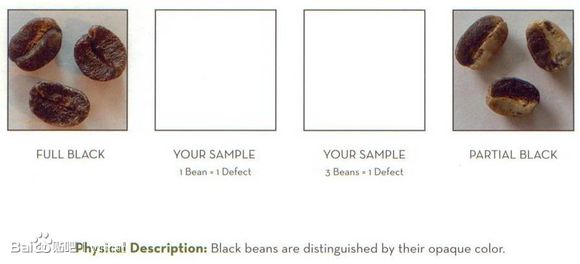
Description: black opaque raw beans
Cup test sensory features: diversification: fermentation taste, sharp choking taste, turbidity, mildew taste, sharp sour taste, chemical irritation and other single or multiple odors mixture.
Cause: excessive fermentation, leading to microbial invasion and infection.
Whole sour beans / partial sour beans

Description: raw beans have a yellow, yellowish-brown or reddish-brown appearance, usually accompanied by blackened embryos (the part shown by the arrow). Acetic acid can be smelled when the beans are cut.
Cup test sensory features: diversity: fermentation taste and even choking taste, depending on the degree of fermentation.
Causes: microbial invasion and infection during overfermentation, harvesting or reprocessing, harvesting overripe berries, or falling berries, or the use of infected or repeated water during washing, or overripe fermentation on trees in humid climates.
Dried berries
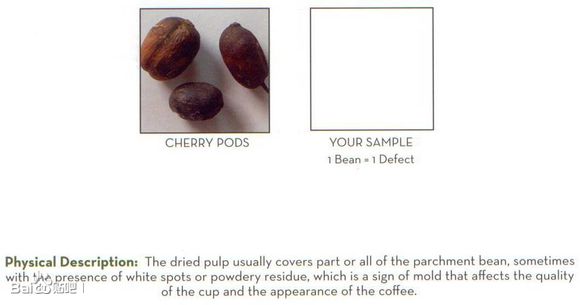
Description: dried berries.
Cup test sensory features: fermentation taste, mildew taste, chemical irritation taste.
Cause: incomplete peeling of berries, or harvesting dried berries.
Fungal infection of bean

Appearance description: raw beans show yellow, yellowish brown or reddish brown spots, which may have a powdery appearance.
Cup test sensory features: diversification: fermentation flavor, turbidity, mildew flavor, soil flavor, chemical irritation and other single or multiple odors mixture.
Cause: fungal spore invasion infection occurred from harvest, post-treatment to storage stage, combined with wet and warm conditions for spore growth and development infection.
Foreign body
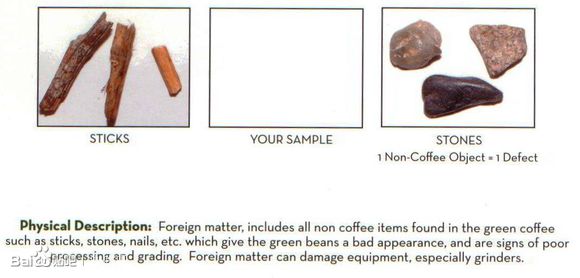
Description: non-coffee impurities, including branches, stones, copper plates, etc.
Sensory features of cup test: produce a variety of odors.
Cause: poor handling.
Floating bean
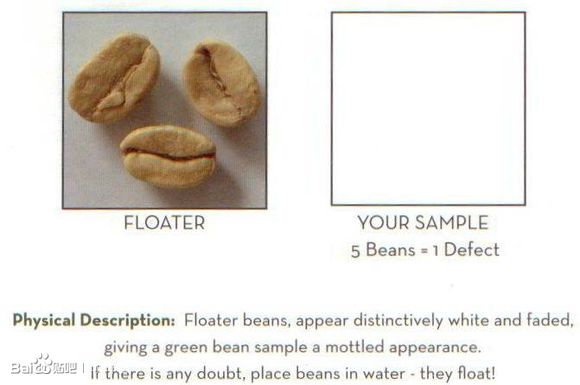
Appearance features: raw beans show a pale appearance, low specific gravity, will float when put in water.
Cup sensory features: diversity: fermented, moldy, earthy, rice stalk or weed green, or does not produce peculiar smell but reduces the taste intensity of coffee.
Causes: improper post-treatment, excessive drying during drying, or long-term storage of shell beans in a high humidity environment.
Shelled bean
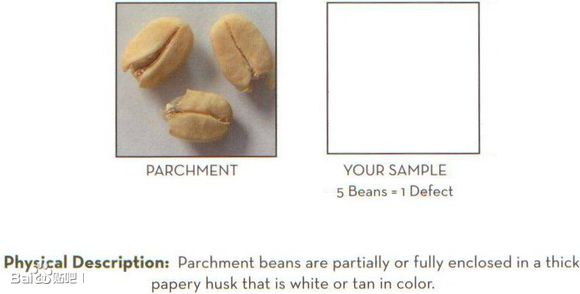
Description: shell beans.
Cause: poor handling.
Unripe bean
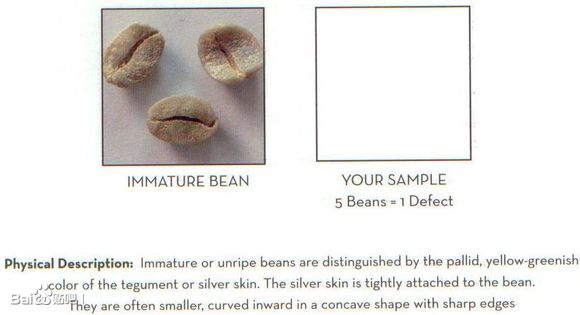
Description: the raw bean is wrapped in yellow-green pale silver skin and is not easy to peel off. The raw bean is curved inside and the edge of the raw bean shows a sharp angle.
Cup test sensory features: diversity: Rice stalk or grass green taste, is the main source of sharp choking taste.
Cause: harvest immature berries, or berries that are too late for ripening at high altitudes.
Withered bean

Appearance description: raw beans show an irregularly wrinkled white appearance, similar to the appearance of raisins.
Cup sensory features: diversity: Rice stalk or weed green.
Cause: during the period of seed development and enrichment, it encountered drought and lack of water, resulting in poor cell development. Coffee plants are malnourished or in poor health, which is also prone to this kind of phenomenon.
Shell bean
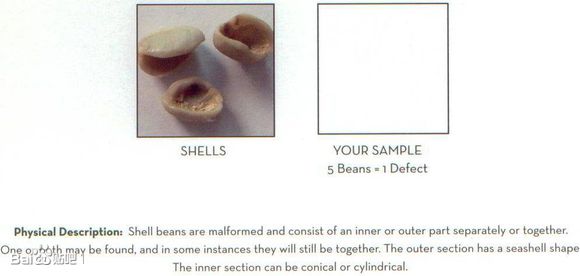
Appearance features: similar to the curly appearance of shells.
Sensory features of cup test: charcoal or charcoal smell.
Cause: genetic characteristics.
Broken / broken beans
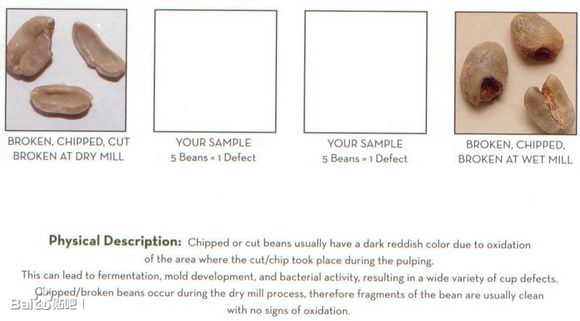
Appearance features: raw beans show broken, broken and other mechanical damage wounds. If it is the process of washing and peeling, the edge of the wound may be black, and if it is the process of shelling and grinding, there should be no black edge.
Cup test sensory features: may produce fermentation taste, turbid, earthy taste, sharp sour taste and other single or multiple peculiar smell mixture.
Moth-eaten bean
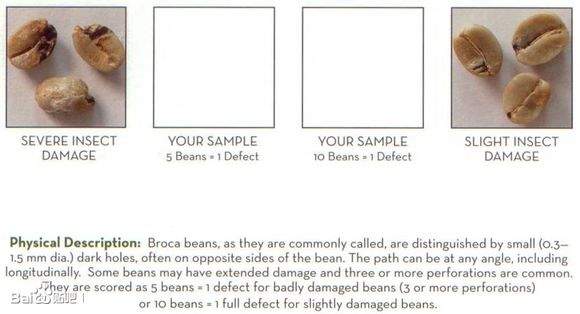
Description: raw beans have perforated wormholes. More than three holes are classified as serious worms, and less than three holes are classified as minor worms.
Cup sensory features: diversification: putrefaction, turbidity, mildew, acidity and other single or multiple odors mixed.
Cause: coffee borer invades and eats seeds during fruit development.
Pericarp / bean shell
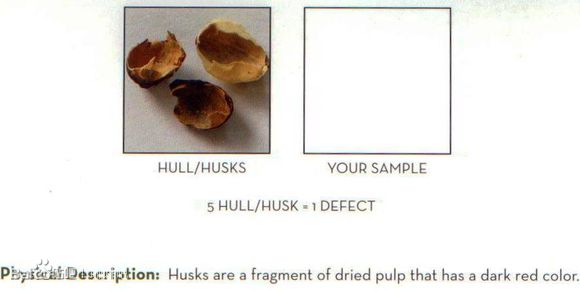
Description: the dried peel is reddish brown (dry treatment) or white bean shell (endocarp).
Cup sensory features: too much pericarp or bean shell may produce a mixture of single or multiple odors, such as fermented flavor, turbid, earthy flavor, mildew flavor, chemical irritating smell and so on.
Cause: poor cleaning.
SCAA Fine Coffee definition:
The evaluation standard of fine coffee issued by SCAA in April 2004, which determines the grades of raw coffee beans and roasted beans respectively, can be divided into fine grade (specialty grade) and excellent grade (premium grade) according to the standards set by the following items.
Water content of raw bean
Coffee size uniformity
Baking uniformity
Defective bean evaluation
Flavor evaluation (cup test): superior features
Number of samples:
350 grams of raw beans
100 grams of cooked beans
Water content of raw coffee beans:
Washing treatment: 10% 12%
Sun treatment: 10% 13%
Coffee bean size and evenness:
SCAA does not stipulate that the size of raw beans must be more than 5% in order to be considered a fine product, but the size must not exceed 5%.
Baking uniformity:
Fine grade (specialty grade): no unbaked beans (Quacker) are allowed
Premium (premium grade): up to 3 Quacker allowed
Defective bean assessment:
SCAA divides defective beans into two levels, 6 first-level defects and 10 second-level defects.
There should be no first-level defects in the fine grade, and the score deducted should not exceed 5 points.
The top grade is allowed to have a first-class defect, but the score deducted cannot exceed 8 points.
First-level defect:
Defective name deducts the number of grains per unit (1 / 1)
All black beans 1
Total sour bean 1
Dried berry 1
Fungal infection bean 1
Foreign body 1
Serious borer bean 5
Secondary flaw:
Defective name deducts the number of grains per unit (1 / 1)
Bureau 3
Local sour bean 3
Shell bean 5
Phaseoda 5
Unripe beans 5
Wilted bean 5
Shell bean 5
Broken beans / broken beans 5
Pericarp / bean shell 5
Light worm borer bean 10
Flavor evaluation:
According to the cup test, a score of more than 80 points is of high quality.
Important Notice :
前街咖啡 FrontStreet Coffee has moved to new addredd:
FrontStreet Coffee Address: 315,Donghua East Road,GuangZhou
Tel:020 38364473
- Prev

The production process of coffee beans A coffee tree can harvest 3 Mel 5 kg of fruit.
A coffee tree can harvest 3-5 kg of fruit, and raw coffee beans account for 1. 5% of the fruit quality. Going from fruit to raw coffee beans is really a time-consuming and laborious task. Arabian, Robusta and Librian Arabian coffee account for about 2% of the world's coffee production. The plant is not suitable for high temperature, low temperature, more rain and less rain. Coffee beans are oval flat and have a high height.
- Next
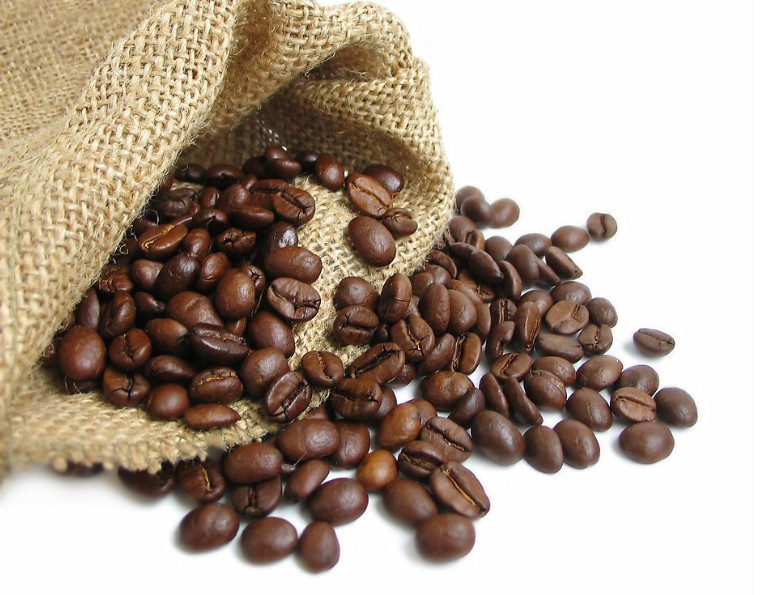
Pay attention to the advantages of women's coffee when drinking coffee tips for buying coffee beans
Drinking coffee has become an indispensable thing for most office white-collar women every day. So, is it good for female friends to drink coffee? At the same time, it takes time to drink coffee. Here, let's introduce them one by one. The benefits of women drinking coffee to prevent allergies. Caffeine can stimulate and excite the sympathetic nerve, so have a drink.
Related
- Guji coffee producing area of Guji, Ethiopia: Humbela, Shakiso, Wulaga
- What is the most expensive variety of Qiloso in BOP multi-variety group?
- How to store the coffee beans bought home?
- Why are Yemeni coffee beans so rare now?
- Ethiopian Sidamo all Red Fruit Sun Sun Santa Vini Coffee beans
- SOE is mostly sour? What does it mean? Is it a single bean? what's the difference between it and Italian blending?
- Is Italian coffee beans suitable for making hand-brewed coffee?
- How to choose coffee beans when making cold coffee? What kind of coffee beans are suitable for making cold coffee?
- Just entered the pit to make coffee, what kind of coffee beans should be chosen?
- Can only Japan buy real Blue Mountain Coffee? What are authentic Jamaican Blue Mountain coffee beans?

